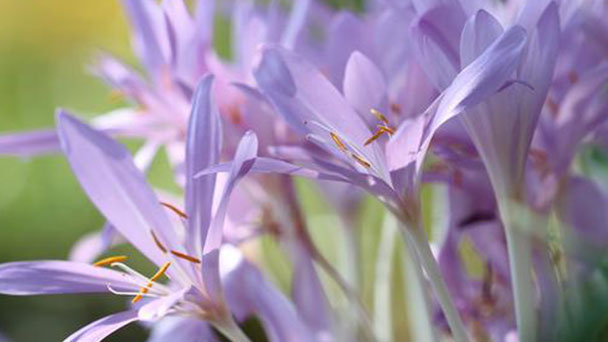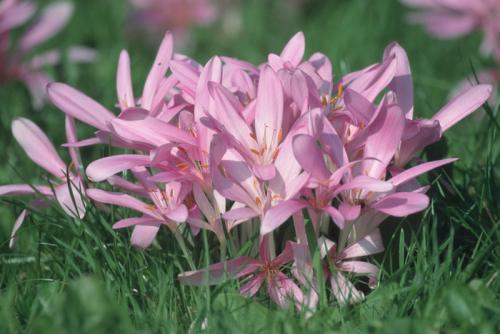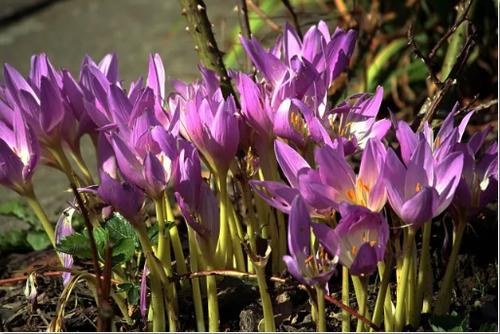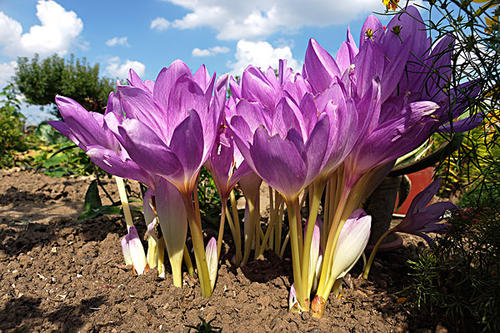Autumn Crocus (Colchicum Autumnale) Profile
Written by Maggie
Nov 05 2021

Autumn Crocus (Colchicum autumnale), also called meadow saffron, naked lady, is a perennial herb with bulbous flowers. Autumn Crocus buds are spindle-shaped, funnel-like when opened, pale pink (or purplish red), dignified and beautiful, popular. The bulbs contain Autumn Crocus alkali, which can be used for medicinal use, especially for polyploid breeding. There are about 60 species of plants in the same genus, most of which bloom only in Autumn without leaves, and the flowers are pink or deep red. 1-4 post flowers are directly extracted from underground stems, which has the reputation of "underground flowers".
Autumn Crocus Picture

Characteristics of Autumn Crocus
Autumn Crocus is a perennial herb with a bulbous flower with an ovate corm and dark brown skin. There is an ovate bulb underground. Stem is very short, mostly buried underground. Leaves are lanceolate, ca. 30cm long. Beautiful reddish flowers first in autumn, and dark linear green leaves in the following spring.Each scapes flowers 1 to 4, buds spindle-shaped, funnel-shaped when open, pale pink (or purplish red), ca. 7 to 8cm in diameter. Stamens of Autumn Crocus are shorter than pistils, anthers yellow. Capsule, seed numerous, irregularly globose, brown. Hydroponics Autumn Crocus is available.
The leaves of Autumn Crocus wilt for some time before the flower stalks come up from the ground.
Habits of Autumn Crocus
Autumn Crocus prefers a cool, dry summer climate, warm and humid winters, full sunshine during the growing season, and fertile, loose and well-drained sandy loam.
Autumn Crocus Distribution
Autumn Crocus is originally grown in Europe and the Mediterranean coast. Since the 1970s, China has imported seeds and bulbs from foreign countries and tried planting them in Beijing, Lushan, Kunming and other places with good results. Garden is often used as a rock garden or flower bed planting. Due to advances in bioengineering science, the demand for Autumn Crocus alkali is increasing, and planting areas are expanding everywhere.
How to Grow & Care for Autumn Crocus
1. Appropriate environment
Autumn Crocus likes a dry, ventilated, and well-lit environment. The suitable temperature for growth of Autumn Crocus is between 18℃ and 25℃, so the temperature of the curing environment should be controlled within this range.
2. Soil care
Autumn Crocus Potted Soil can be a loose, breathable, well-drained, humus-rich, slightly acidic or neutral soil (pH 6.1 to 7.5). Home potted soil can be a mixture of leaf rot, peat and plant ash.
3. Lighting care
Autumn Crocus likes a sunny environment, usually in all seasons except the summer shade, but especially in the winter, make sure you get enough light.
With about six hours of light a day, Autumn Crocus grew well.
4. Watering care
Watering Autumn Crocus varies according to the season, as described below:
Summer is more blind for dry environments, in the summer can be a small amount of water, to keep the environment dry.
Water the Autumn Crocus at the same time as you can. Water the Autumn Crocus at the same time as you can.
Autumn Crocus is cold resistant in winter, so you can water more and more in winter, but you must control the amount of watering to avoid water.
5. Fertilizer
The growth of any plant depends on nutrients, and so does the Autumn Crocus. In order to grow well, especially during the growth period, you need to apply enough fertilizer to the Autumn Crocus. In addition, you need to apply enough fertilizer to the Autumn Crocus just before flowering to facilitate the flowering and growth.
6. Potting and Repotting
You can grow autumn crocus in pots, but they may not return reliably for the next growing season. Pot them up in mid-summer, using a standard potting mix, and water when the soil is dry. After bloom and the first hard freeze, place the pot in a shed or garage to prevent frost heaving. Repot when corms become crowded every few years.
7. Pruning
As with all flowering bulbs, it is necessary no longer to reduce returned the foliage of the plant, however to enable it to die lower back naturally. You can prune away the foliage when it has grew to become yellow.

How to Propagate Autumn Crocus
Your autumn crocus bulbs will naturally make it bigger to shape a colony with the aid of forming small bulblets on the essential corm. You can take gain of this with the aid of digging the bulbs and casting off these new child bulbs in the summer, when flowers are dormant. Replant them six inches apart, and they will make bigger and attain blooming measurement in a couple of seasons.
Varieties of Autumn Crocus
The clear white blooms of autumn crocus 'Innocence' shine in in part shady gardens. The thoroughly double crimson blooms of 'Water Lily' fill backyard gaps beautifully. The checkered purple blooms of 'Disraeli' make a charming addition to the fall garden, and deserve shut inspection.
Autumn Crocus 'Innocence'
Autumn Crocus 'Innocence' Chris Burrows/Getty Images
Autumn Crocus 'Waterlily'
Autumn Crocus 'Disraeli'
How to Grow Autumn Crocus in Containers
Growing autumn crocus in containers is exciting when you mix them with a mounding plant like wax begonia, and then wait for the shock plant life to show up in the fall. Container-grown autumn crocus plant life may additionally perennialize in zones seven and eight. (Find more fall plants here.)
How to Grow Autumn Crocus from seeds
Cover seeds so that they are simply buried, and sow outside in the fall, as seeds want a relaxed duration to set off germination. Germination is slow, and can also take 12 months in some cases.
Autumn Crocus Pests & Diseases
Overly wet soils are typically the purpose of pest and sickness outbreaks in the autumn crocus. Slugs and snails may also trouble vegetation in moist, shaded gardens. Wet soils with terrible drainage can lead to mildew or corm rot. Plant in raised beds in full solar to forestall moisture issues.
Autumn Crocus Uses
Autumn Crocus is suitable for alpine and rock gardens. It can also be planted in bushes, flowers and lawns. Flowers of Autumn Crocus are near the ground, unique. The Autumn Crocus base can be extracted from the bulb for medicinal use.

Read Next:
Top 10 Most Beautiful Roses in the World
Top 10 Most Beautiful Flowers in the World
26 Best Autumn Flowers to Plant for Fall Color in Garden
Top 30 Fall Flowers to Plant - Beautiful Autumn Flowers
30 Fall Plants for a Beautiful Fall Garden
Latest Updated
- Benefits of Bugleweed - 7 Science-backed Health Benefits
- Bugleweed Dangers & Side Effects - Is It Poisonous?
- How to Plant Evergreen Trees - What You Should Know
- When to Plant Evergreens - Grow Guide for Evergreen Trees
- 12 Wonderful Evergreen Shrubs for Your Garden
- 12 Popular Evergreen Plants with Pictures for Beginners
- When And How To Prune A Lilac Bush Like a Pro
- How to Grow & Care for Lilac Vine (Hardenbergia Violacea)
- Japanese Lilac Tree (Syringa Reticulata) Care & Propagation Guide
- Shumard Oak Pros and Cons - What to Know
Popular Articles
- Winter maintenance of Antirrhinum Majus
- How to Grow Terminalia Mantaly Tree
- How to Grow and Care for Crossostephium Chinense
- How to grow Antirrhinum Majus in spring
- Peristeria Elata (Dove Orchid) Profile: Info & Care Guide
- Underwatered Snake Plant (Sansevieria Trifasciata) - Signs And How To Fix
- How to Care for Brazilian Jasmine Plant (Mandevilla Sanderi)
- How to Grow & Care for Graptopetalum Purple Delight in Summer
- Rosa Chinensis (China Rose): Plant Growing & Care Tips
- How to Care for Baby Sun Rose (Aptenia Cordifolia)